Professional Mechanical Tooth Cleaning Method for Dental Implant Surface by Agar Particle Blasting
Abstract
:1. Introduction
2. Materials and Methods
2.1. Effect of Difference in Jet Particles on Titanium Surface
2.1.1. Sample Preparation
2.1.2. Injection Device and Injection Particles
2.1.3. Experimental Methods
2.2. Effect of Different Agar Particles on the Titanium Surface
2.2.1. Effect of Different Sizes of Agar Particles on the Dirt on the Titanium Surface
2.2.2. Effect of Different Sizes of Agar Particles on the Tartar Model on the Titanium Surface
2.3. Statistical Analysis
3. Results
3.1. Effect of Difference in Jet Particles on Titanium Surface
3.2. Effect of Different Sizes of Agar Particles on the Dirt on the Titanium Surface
3.3. Effect of Different Sizes of Agar Particles on the Tartar Model on the Titanium Surface
4. Discussion
5. Conclusions
Author Contributions
Funding
Institutional Review Board Statement
Informed Consent Statement
Data Availability Statement
Acknowledgments
Conflicts of Interest
References
- Lindhe, J.; Karring, T.; Lang, N.P. Clinical Periodontology and Implant Dentistry; Blackwell Publishing: Hoboken, NJ, USA, 2003. [Google Scholar]
- Misch, C.E. Contemporary Implant Dentistry. Implant Dent. 1999, 8, 90. [Google Scholar] [CrossRef]
- Cairo, F.; Pagliaro, U.; Nieri, M. Soft Tissue Management at Implant Sites. J. Clin. Periodontol. 2008, 35, 163–167. [Google Scholar] [CrossRef] [PubMed]
- Tebbetts, J.B.; Hammond, D.C. A System for Breast Implant Selection Based on Patient Tissue Characteristics and Implant-Soft Tissue Dynamics. Plast. Reconstr. Surg. 2002, 109, 1396–1409; discussion 1410. [Google Scholar] [CrossRef] [PubMed]
- Wennström, J.L.; Bengazi, F.; Lekholm, U. The Influence of the Masticatory Mucosa on the Peri-Implant Soft Tissue Condition. Clin. Oral Implant. Res. 1994, 5, 1–8. [Google Scholar] [CrossRef] [PubMed]
- Bernardi, S.; Bianchi, S.; Tomei, A.R.; Continenza, M.A.; Macchiarelli, G. Microbiological and SEM-EDS evaluation of titanium surfaces exposed to periodontal gel: In vitro study. Materials 2019, 12, 1448. [Google Scholar] [CrossRef] [PubMed] [Green Version]
- Kaiser, F.; Scharnweber, D.; Bierbaum, S.; Wolf-Brandstetter, C. Success and side effects of different treatment options in the low current attack of bacterial biofilms on titanium implants. Bioelectrochemistry 2020, 133, 107485. [Google Scholar] [CrossRef]
- Klinge, B.; Hultin, M.; Berglundh, T. Peri-Implantitis. Dent. Clin. N. Am. 2005, 49, 661–676. [Google Scholar] [CrossRef]
- Prathapachandran, J.; Suresh, N. Management of Peri-Implantitis. Dent. Res. J. 2012, 9, 516–521. [Google Scholar] [CrossRef]
- Mahato, N.; Wu, X.; Wang, L. Management of Peri-Implantitis: A Systematic Review, 2010–2015. Springerplus 2016, 5, 105. [Google Scholar] [CrossRef] [Green Version]
- Mombelli, A. Etiology, Diagnosis, and Treatment Considerations in Peri-Implantitis. Curr. Opin. Periodontol. 1997, 4, 127–136. [Google Scholar]
- Jacombs, A.; Tahir, S.; Hu, H.; Deva, A.K.; Almatroudi, A.; Wessels, W.L.F.; Bradshaw, D.A.; Vickery, K. In Vitro and In Vivo Investigation of the Influence of Implant Surface on the Formation of Bacterial Biofilm in Mammary Implants. Plast. Reconstr. Surg. 2014, 133, 471e–480e. [Google Scholar] [CrossRef] [PubMed]
- Pita, P.P.C.; Rodrigues, J.A.; Ota-Tsuzuki, C.; Miato, T.F.; Zenobio, E.G.; Giro, G.; Figueiredo, L.C.; Gonçalves, C.; Gehrke, S.A.; Cassoni, A.; et al. Oral Streptococci Biofilm Formation on Different Implant Surface Topographies. BioMed Res. Int. 2015, 2015, 159625. [Google Scholar] [CrossRef] [PubMed]
- Daubert, D.M.; Weinstein, B.F. Biofilm as a Risk Factor in Implant Treatment. Periodontology 2019, 81, 29–40. [Google Scholar] [CrossRef] [PubMed]
- Lin, H.Y.; Liu, Y.; Wismeijer, D.; Crielaard, W.; Deng, D.M. Effects of Oral Implant Surface Roughness on Bacterial Biofilm Formation and Treatment Efficacy. Int. J. Oral Maxillofac. Implant. 2013, 28, 1226–1231. [Google Scholar] [CrossRef] [PubMed]
- Esposito, M.; Grusovin, M.G.; Worthington, H.V. Treatment of Peri-Implantitis: What Interventions Are Effective? A Cochrane Systematic Review. Eur. J. Oral Implantol. 2012, 5, S21–S41. [Google Scholar]
- Haritha, V.; Sasikumar, K.G.; Prathapachandran, R.; Anoop, M. Contemplating Macrotyloma Uniflorumin Traditional Snake Envenomation Management Practices Through Analysis on Various Solvents by a Scheme of Spectroscopic, Phytochemical and Chromatographical Analysis. Int. J. Curr. Res. Biosci. Plant. Biol. 2020, 7, 40–45. [Google Scholar]
- Claffey, N.; Clarke, E.; Polyzois, I.; Renvert, S. Surgical Treatment of Peri-Implantitis. J. Clin. Periodontol. 2008, 35, 316–332. [Google Scholar] [CrossRef]
- Schou, S.; Berglundh, T.; Lang, N.P. Surgical Treatment of Peri-Implantitis. Int. J. Oral Maxillofac. Implant. 2004, 19, 140–149. [Google Scholar]
- Renvert, S.; Lessem, J.; Dahlén, G.; Renvert, H.; Lindahl, C. Mechanical and Repeated Antimicrobial Therapy Using a Local Drug Delivery System in the Treatment of Peri-Implantitis: A Randomized Clinical Trial. J. Periodontol. 2008, 79, 836–844. [Google Scholar] [CrossRef] [PubMed]
- Persson, G.R.; Salvi, G.E.; Heitz-Mayfield, L.J.; Lang, N.P. Antimicrobial Therapy Using a Local Drug Delivery System (Arestin) in the Treatment of Peri-Implantitis. I: Microbiological Outcomes. Clin. Oral Implant. Res. 2006, 17, 386–393. [Google Scholar] [CrossRef]
- Renvert, S.; Roos-Jansåker, A.M.; Claffey, N. Non-Surgical Treatment of Peri-Implant Mucositis and Peri-Implantitis: A Literature Review. J. Clin. Periodontol. 2008, 35, 305–315. [Google Scholar] [CrossRef] [PubMed]
- Dörtbudak, O.; Haas, R.; Bernhart, T.; Mailath-Pokorny, G. Lethal Photosensitization for Decontamination of Implant Surfaces in the Treatment of Peri-Implantitis. Clin. Oral Implant. Res. 2001, 12, 104–108. [Google Scholar] [CrossRef] [Green Version]
- Hanada, N. The Dental Drug Delivery System for Prevention of Dental Caries. Curr. Oral Health Rep. 2016, 3, 124–128. [Google Scholar] [CrossRef]
- Park, J.-W.; Kook, M.-S.; Park, H.-J.; Shet, U.-K.; Choi, C.-H.; Hong, S.-J.; Oh, H.-K. Comparative Study of Removal Effect on Artificial Plaque from RBM Treated Implant. Maxillofac. Plast. Reconstr. Surg. 2007, 29, 309–320. [Google Scholar]
- Cho, M.J. The Effectiveness Focused on Professional Mechanical Tooth Cleaning for Implant Patients Management. Int. J. Clin. Prev. Dent. 2019, 15, 38–47. [Google Scholar] [CrossRef]
- Vieira, L.F.N.; Dias, E.C.L.D.C.E.M.; Cardoso, E.S.; Machado, S.J.; da Silva, C.P.; Vidigal, G.M. Effectiveness of Implant Surface Decontamination Using a High-Pressure Sodium Bicarbonate Protocol. Implant. Dent. 2012, 21, 390–393. [Google Scholar] [CrossRef]
- Augthun, M.; Tinschert, J.; Huber, A. In Vitro Studies on the Effect of Cleaning Methods on Different Implant Surfaces. J. Periodontol. 1998, 69, 857–864. [Google Scholar] [CrossRef]
- John, G.; Becker, J.; Schwarz, F. Effectivity of Airabrasive Powder Based on Glycine and Tricalcium Phosphate in Removal of Initial Biofilm on Titanium and Zirconium Oxide Surfaces in an Ex Vivo Model. Clin. Oral Investig. 2016, 20, 711–719. [Google Scholar] [CrossRef]
- Cochis, A.; Fini, M.; Carrassi, A.; Migliario, M.; Visai, L.; Rimondini, L. Effect of Air Polishing With Glycine Powder on Titanium Abutment Surfaces. Clin. Oral Implant. Res. 2013, 24, 904–909. [Google Scholar] [CrossRef]
- Tastepe, C.S.; Liu, Y.; Visscher, C.M.; Wismeijer, D. Cleaning and Modification of Intraorally Contaminated Titanium Discs with Calcium Phosphate Powder Abrasive Treatment. Clin. Oral Implant. Res. 2013, 24, 1238–1246. [Google Scholar] [CrossRef] [Green Version]
- Subramani, K.; Jung, R.E.; Molenberg, A.; Hammerle, C.H. Biofilm on Dental Implants: A Review of the Literature. Int. J. Oral Maxillofac. Implant. 2009, 24, 616–626. [Google Scholar]
- Amano, A.; Nakagawa, I.; Okahashi, N.; Hamada, N. Variations of Porphyromonas gingivalis Fimbriaein Relation to Microbial Pathogenesis. J. Periodont. Res. 2004, 39, 136–142. [Google Scholar] [CrossRef] [PubMed]
- White, D.J. Dental calculus: Recent insights into occurrence, formation, prevention, removal and oral health effects of supragingival and subgingival deposits. Eur. J. Oral Sci. 1997, 105, 508–522. [Google Scholar] [CrossRef]
- Rimondini, L.; Farè, S.; Brambilla, E.; Felloni, A.; Consonni, C.; Brossa, F.; Carrassi, A. The Effect of Surface Roughness on Early In Vivo Plaque Colonization on Titanium. J. Periodontol. 1997, 68, 556–562. [Google Scholar] [CrossRef]
- Takagi, T.; Aoki, A.; Ichinose, S.; Taniguchi, Y.; Tachikawa, N.; Shinoki, T.; Meinzer, W.; Sculean, A.; Izumi, Y. Effective Removal of Calcified Deposits on Microstructured Titanium Fixture Surfaces of Dental Implants with Erbium Lasers. J. Periodontol. 2018, 89, 680–690. [Google Scholar] [CrossRef]
- Liu, X.; Chen, S.; Tsoi, J.K.H.; Matinlinna, J.P. Binary Titanium Alloys as Dental Implant Materials—A Review. Regen. Biomater. 2017, 4, 315–323. [Google Scholar] [CrossRef] [Green Version]
- Nouri, A. Titanium Foam Scaffolds for Dental Applications. In Metallic Foam Bone; Woodhead Publishing: Cambridge, UK, 2017; pp. 131–160. [Google Scholar]
- Gehrke, S.A.; de Lima, J.H.C.; Rodriguez, F.; Calvo-Guirado, J.L.; Aramburú Júnior, J.; Pérez-Díaz, L.; Mazón, P.; Aragoneses, J.M.; De Aza, P.N. Microgrooves and Microrugosities in Titanium Implant Surfaces: An In Vitro andiIn Vivo Evaluation. Materials 2019, 12, 1287. [Google Scholar] [CrossRef] [Green Version]
- Dohan Ehrenfest, D.M.; Coelho, P.G.; Kang, B.S.; Sul, Y.T.; Albrektsson, T. Classification of Osseointegrated Implant Surfaces: Materials, Chemistry and Topography. Trends Biotechnol. 2010, 28, 198–206. [Google Scholar] [CrossRef]
- Nicolas-Silvente, A.I.; Velasco-Ortega, E.; Ortiz-Garcia, I.; Monsalve-Guil, L.; Gil, J.; Jimenez-Guerra, A. Influence of the Titanium Implant Surface Treatment on the Surface Roughness and Chemical Composition. Materials 2020, 13, 314. [Google Scholar] [CrossRef] [Green Version]
- Cervino, G.; Fiorillo, L.; Iannello, G.; Santonocito, D.; Risitano, G.; Cicciù, M. Sandblasted and Acid Etched Titanium Dental Implant Surfaces Systematic Review and Confocal Microscopy Evaluation. Materials 2019, 12, 1763. [Google Scholar] [CrossRef] [Green Version]
- Zhang, H.; Komasa, S.; Mashimo, C.; Sekino, T.; Okazaki, J. Effect of Ultraviolet Treatment on Bacterial Attachment and Osteogenic Activity to Alkali-Treated Titanium with Nanonetwork Structures. Int. J. Nanomed. 2017, 12, 4633–4646. [Google Scholar] [CrossRef] [PubMed] [Green Version]
- Sahrmann, P.; Ronay, V.; Hofer, D.; Attin, T.; Jung, R.E.; Schmidlin, P.R. In Vitro Cleaning Potential of Three Different Implant Debridement Methods. Clin. Oral Implant. Res. 2015, 26, 314–319. [Google Scholar] [CrossRef] [PubMed]
- Safi, I.N.; Hussein, B.M.A.; Al Shammari, A.M.; Tawfiq, T.A. Implementation and Characterization of Coating Pure Titanium Dental Implant With Sintered α-TCP by Using Nd: YAG Laser. Saudi Dent. J. 2019, 31, 242–250. [Google Scholar] [CrossRef] [PubMed]
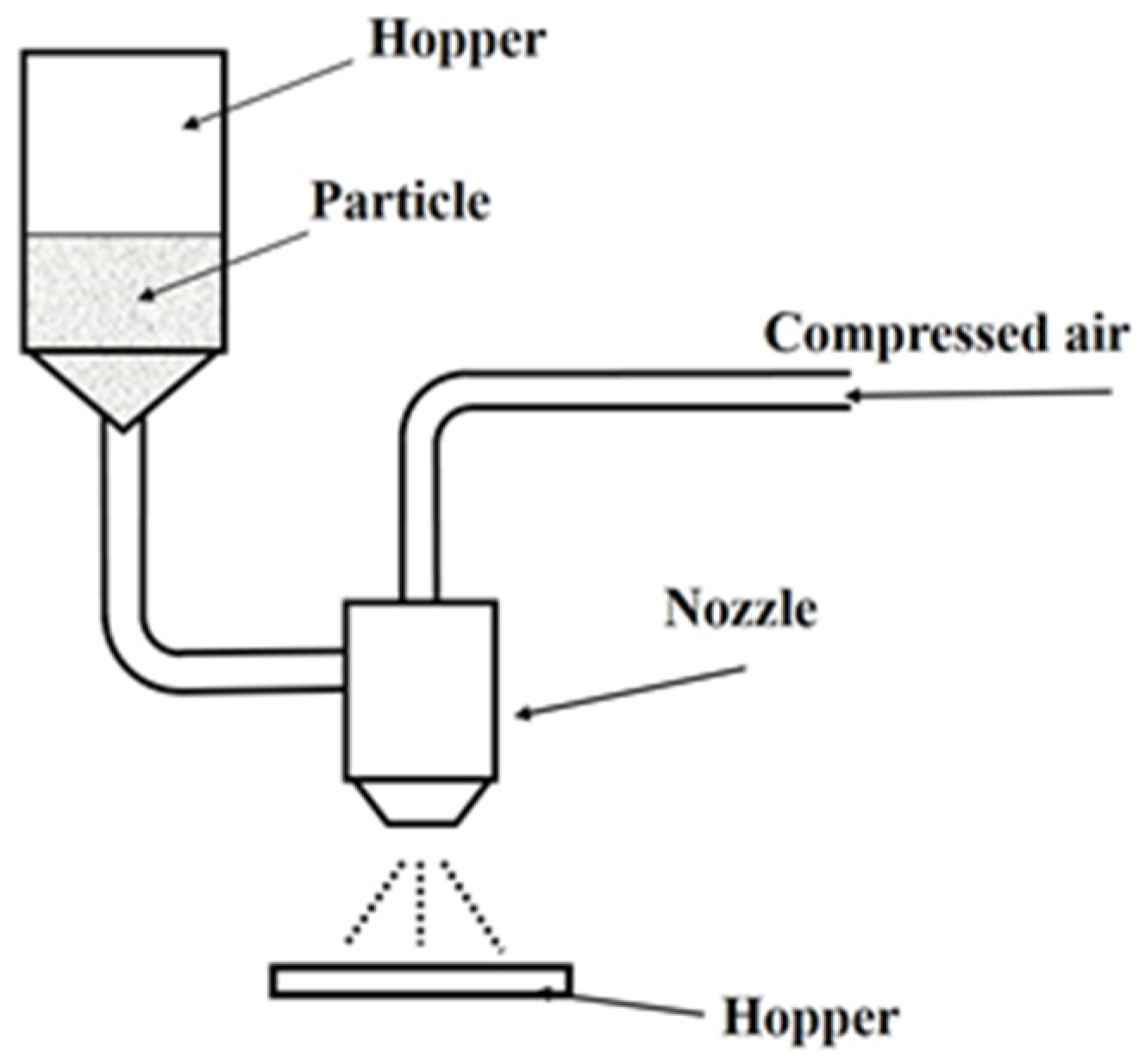
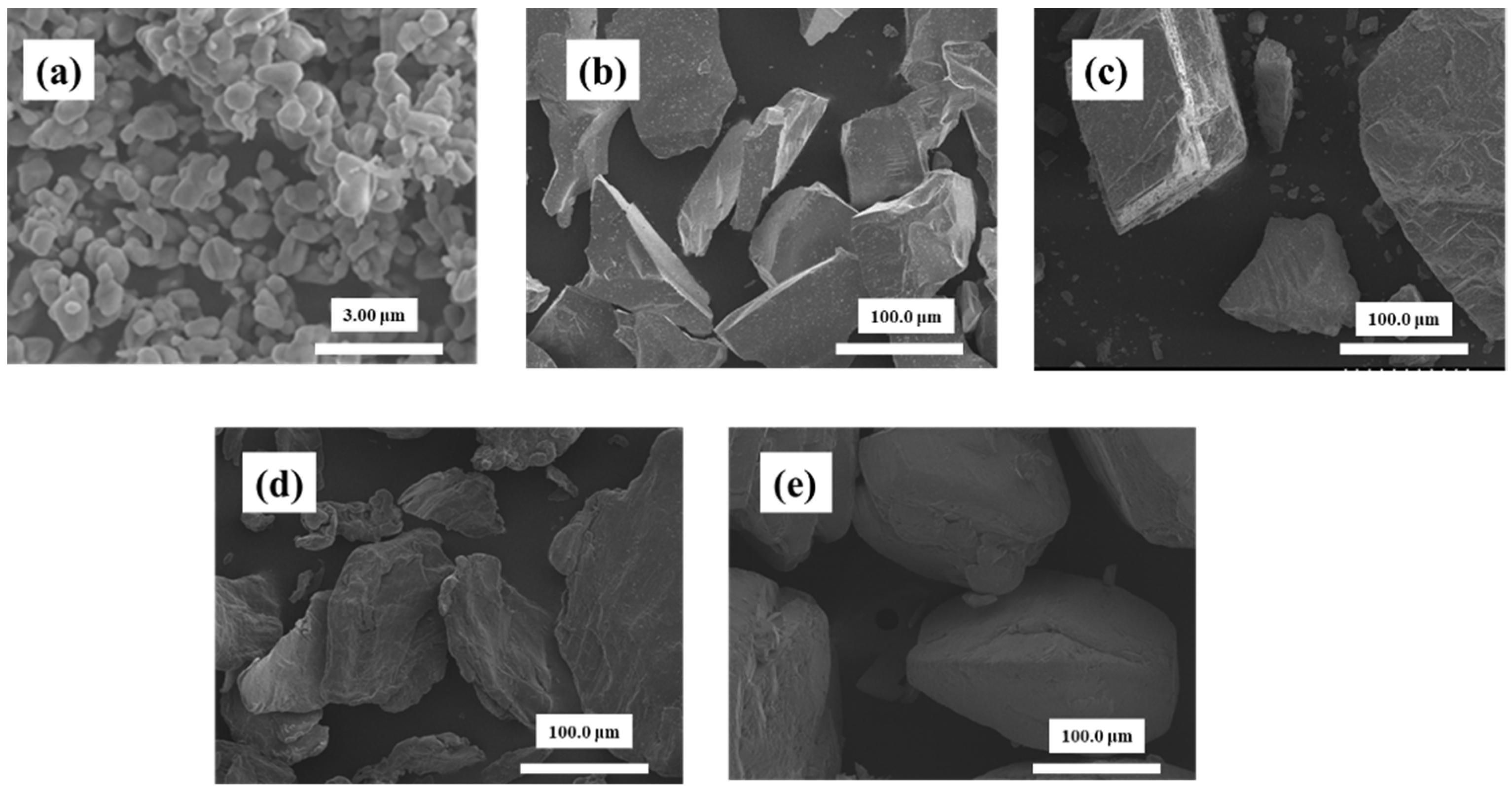


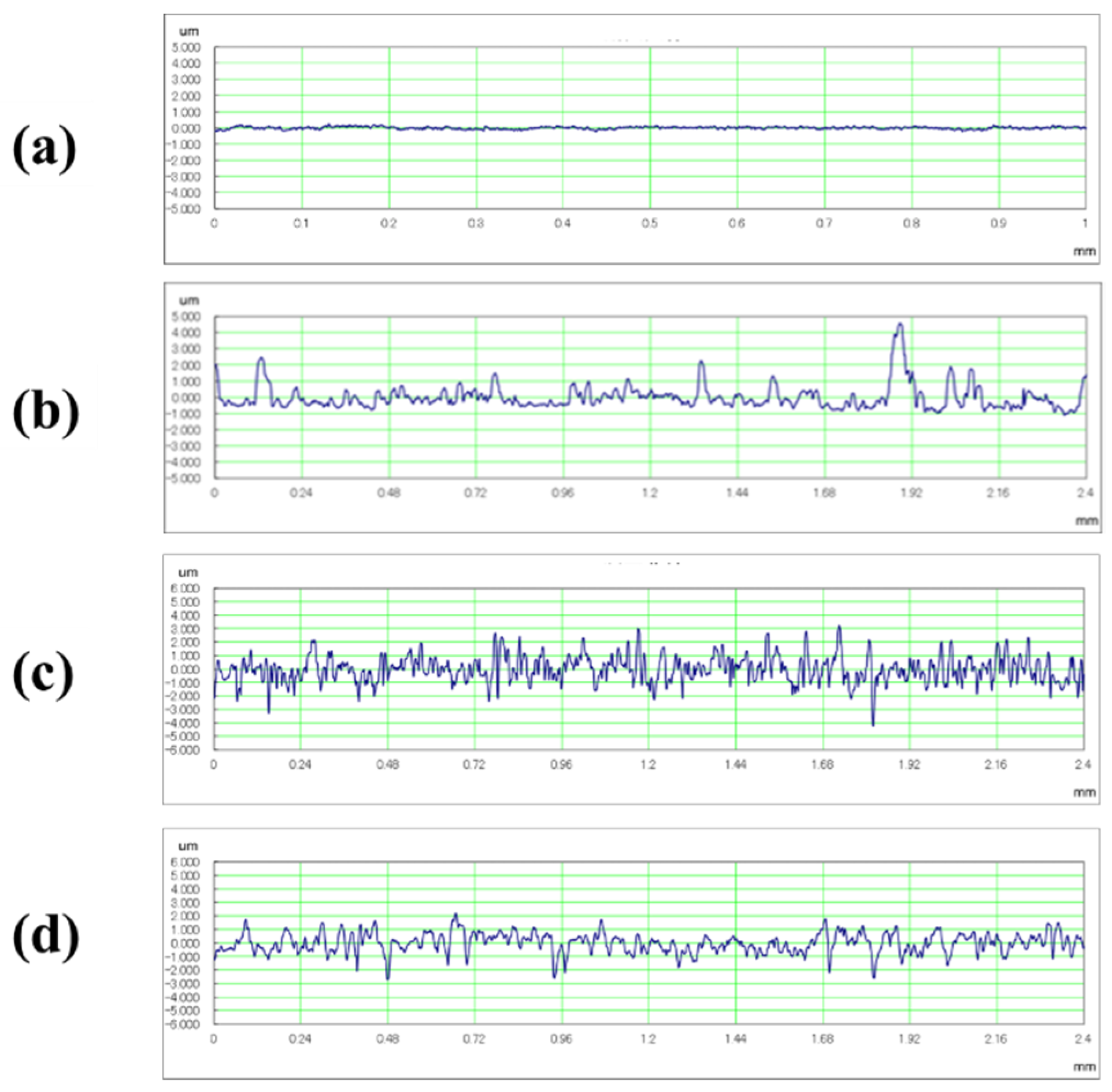
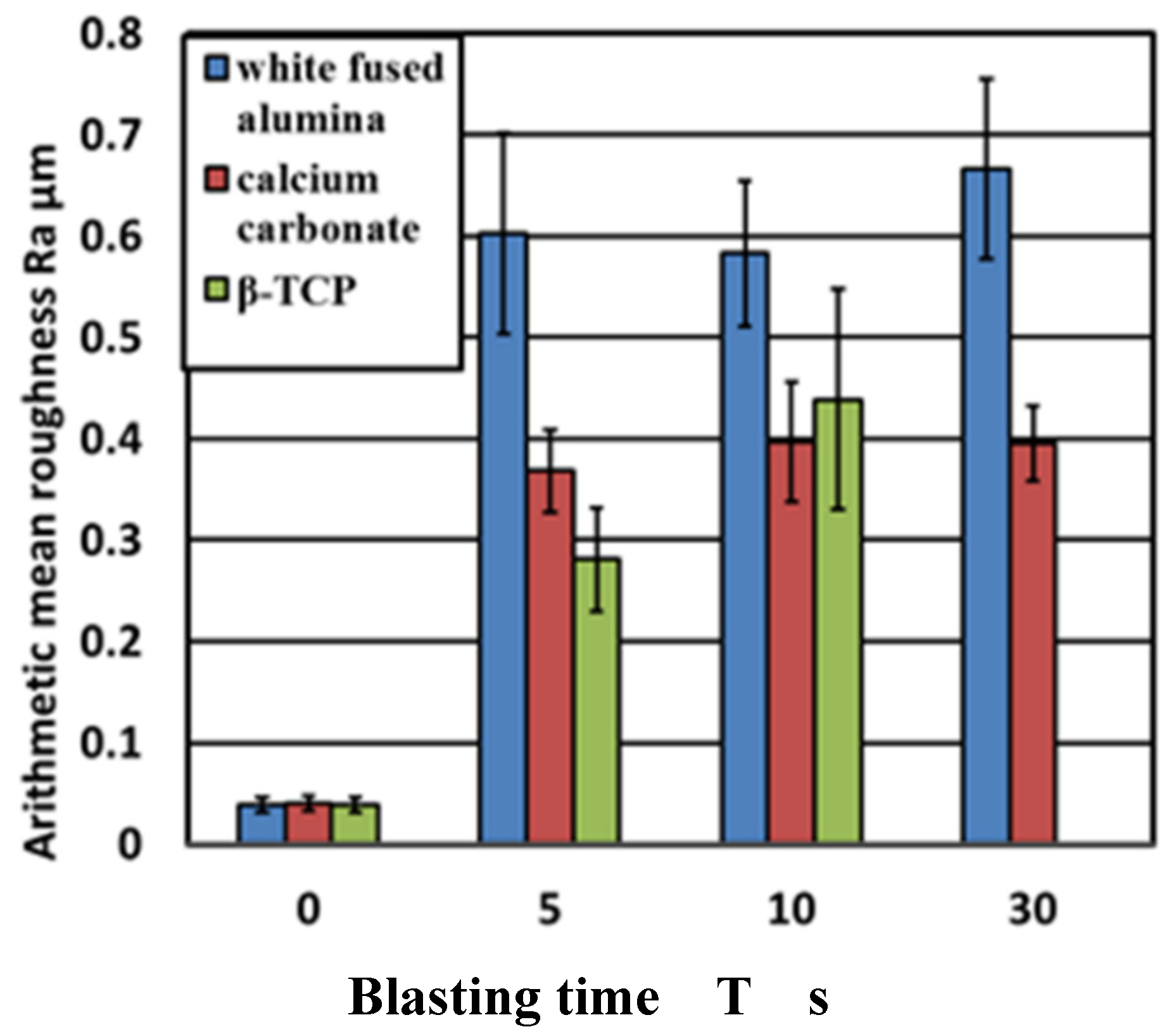
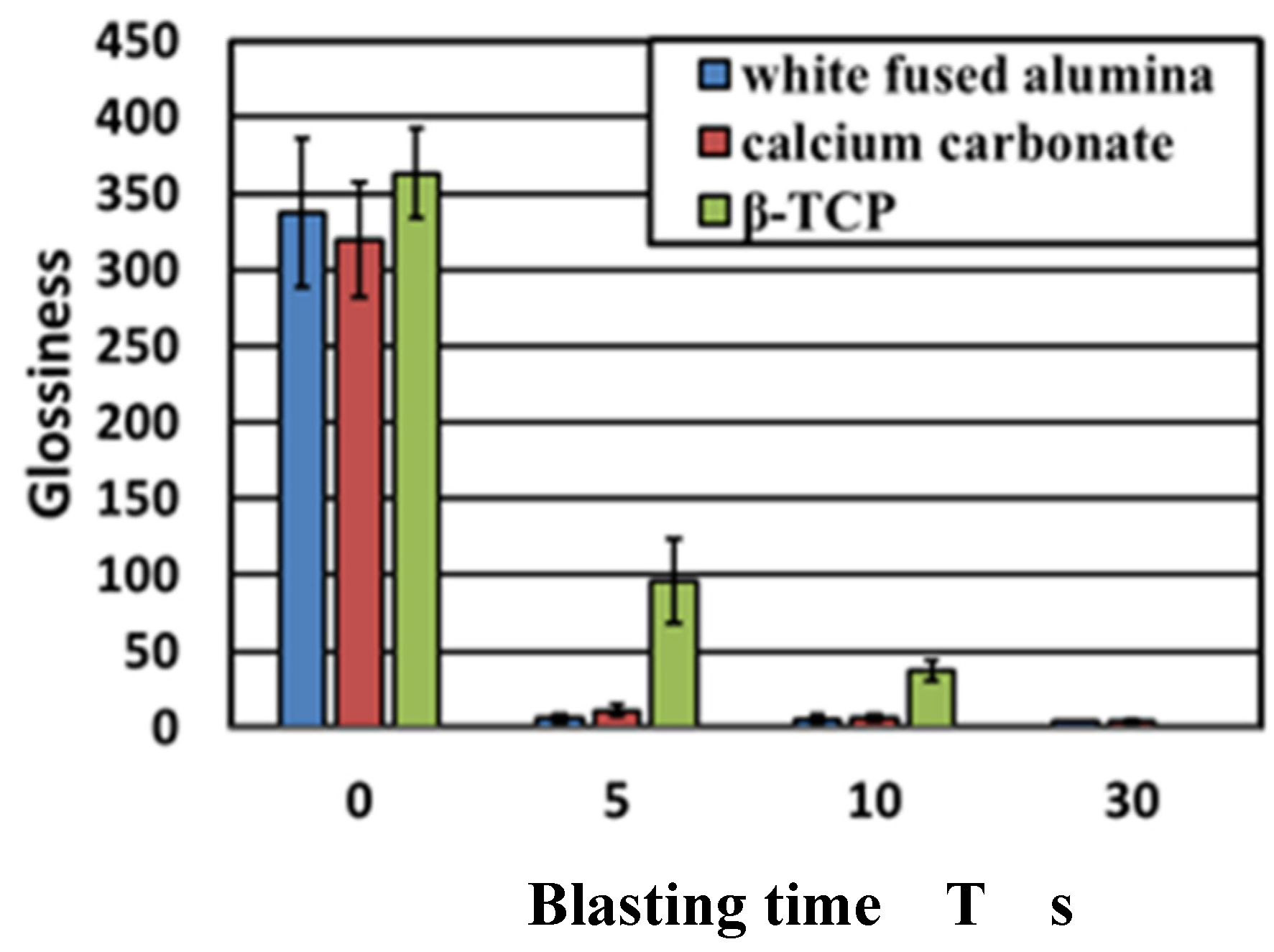

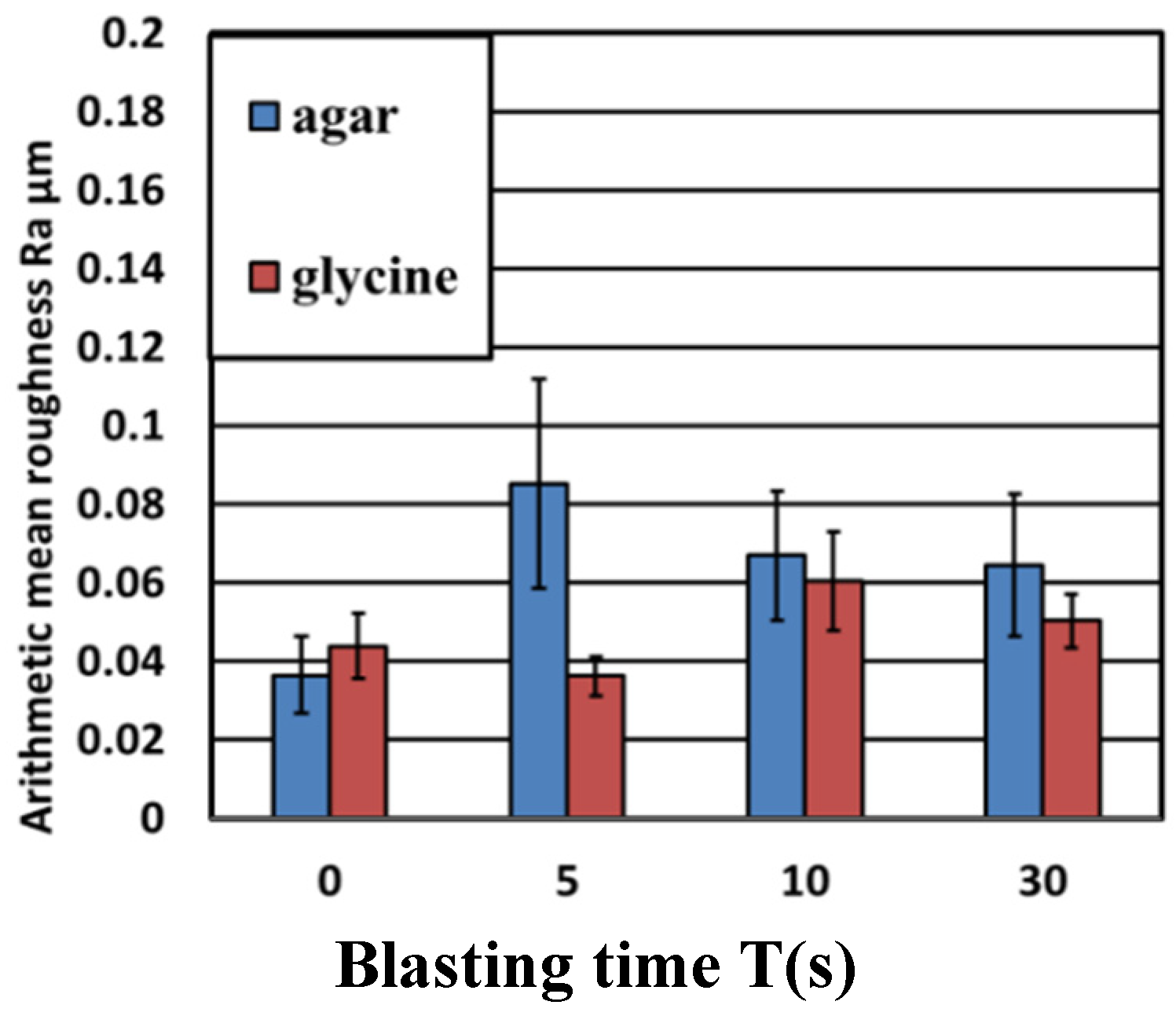
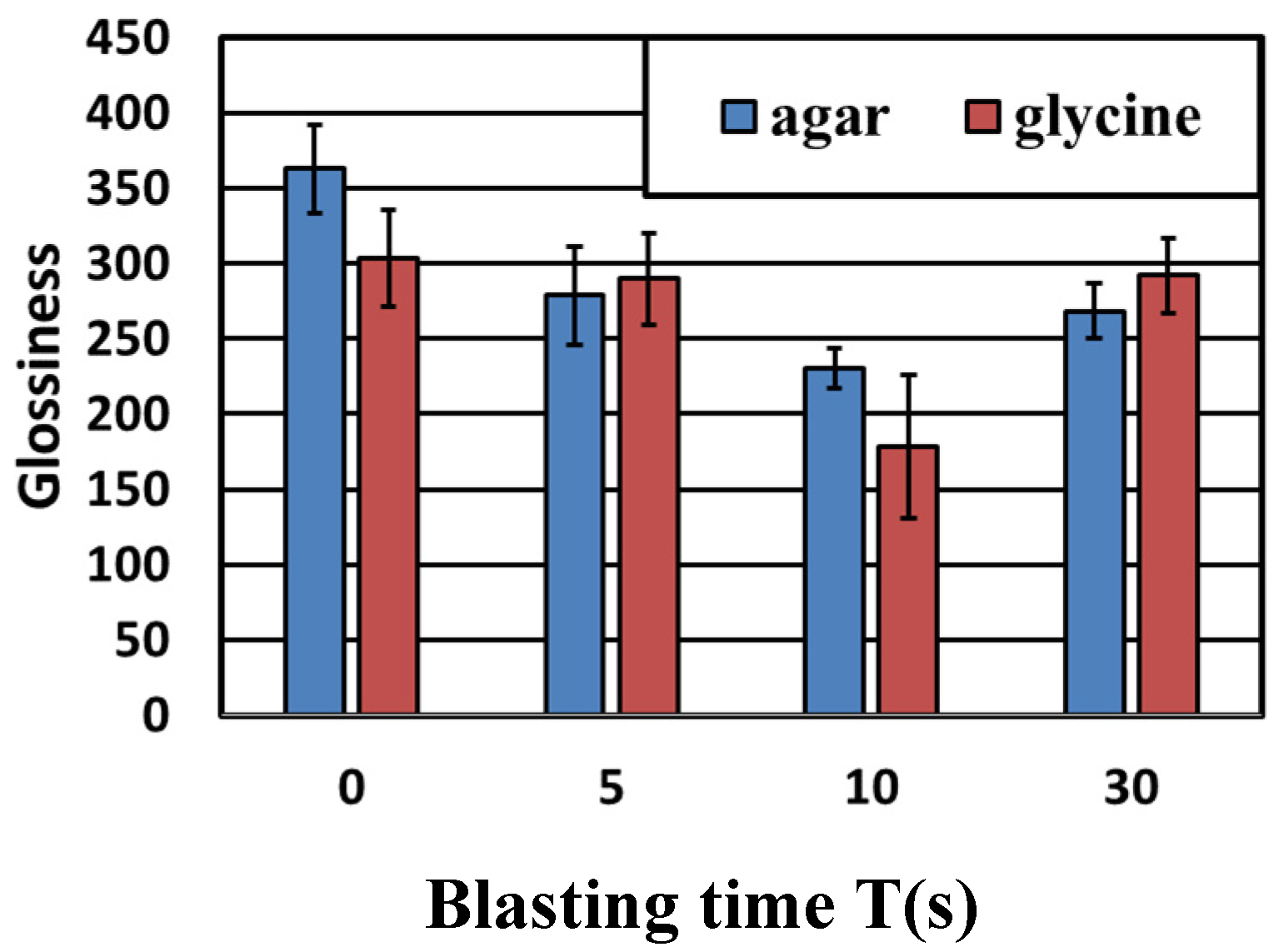
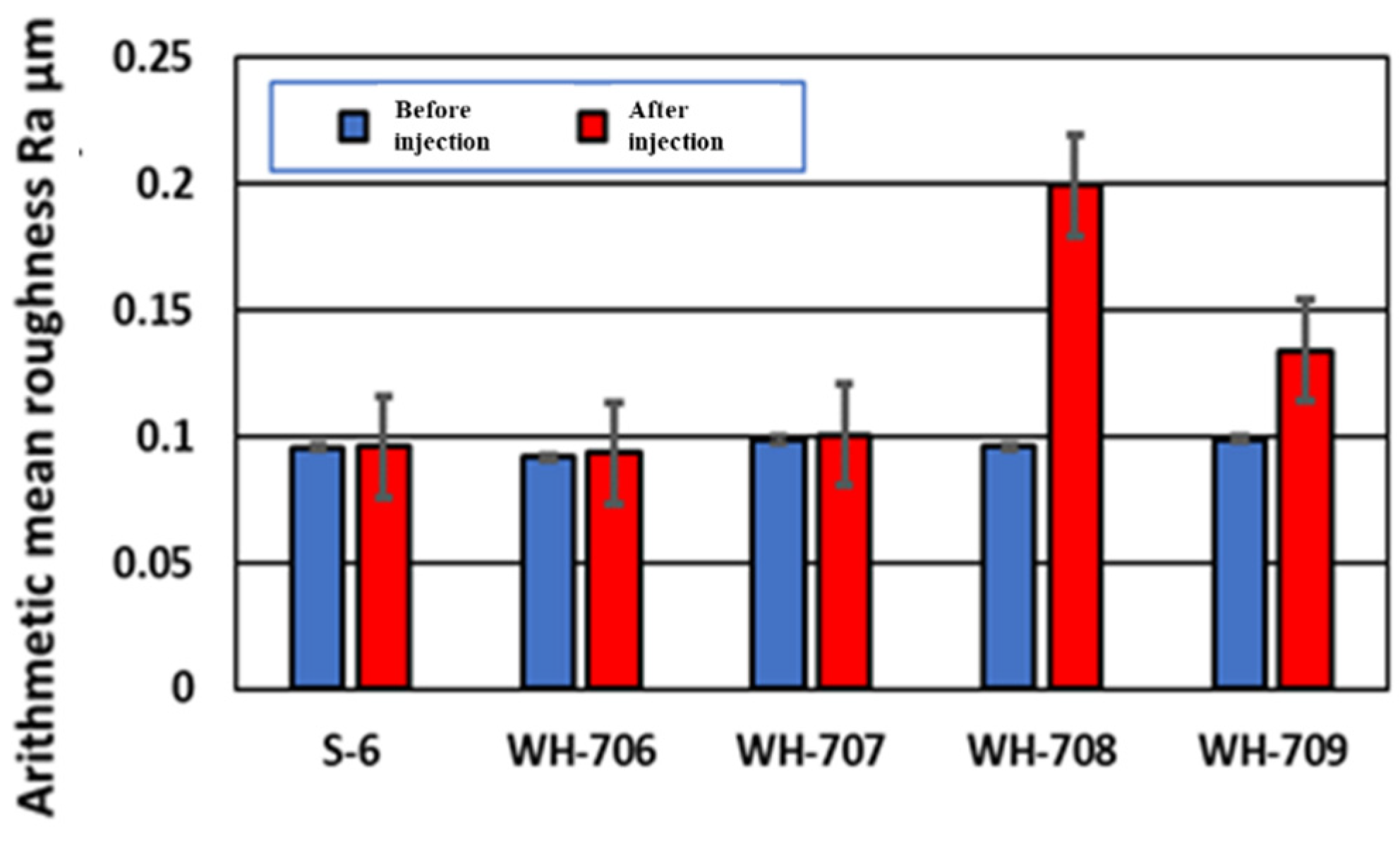


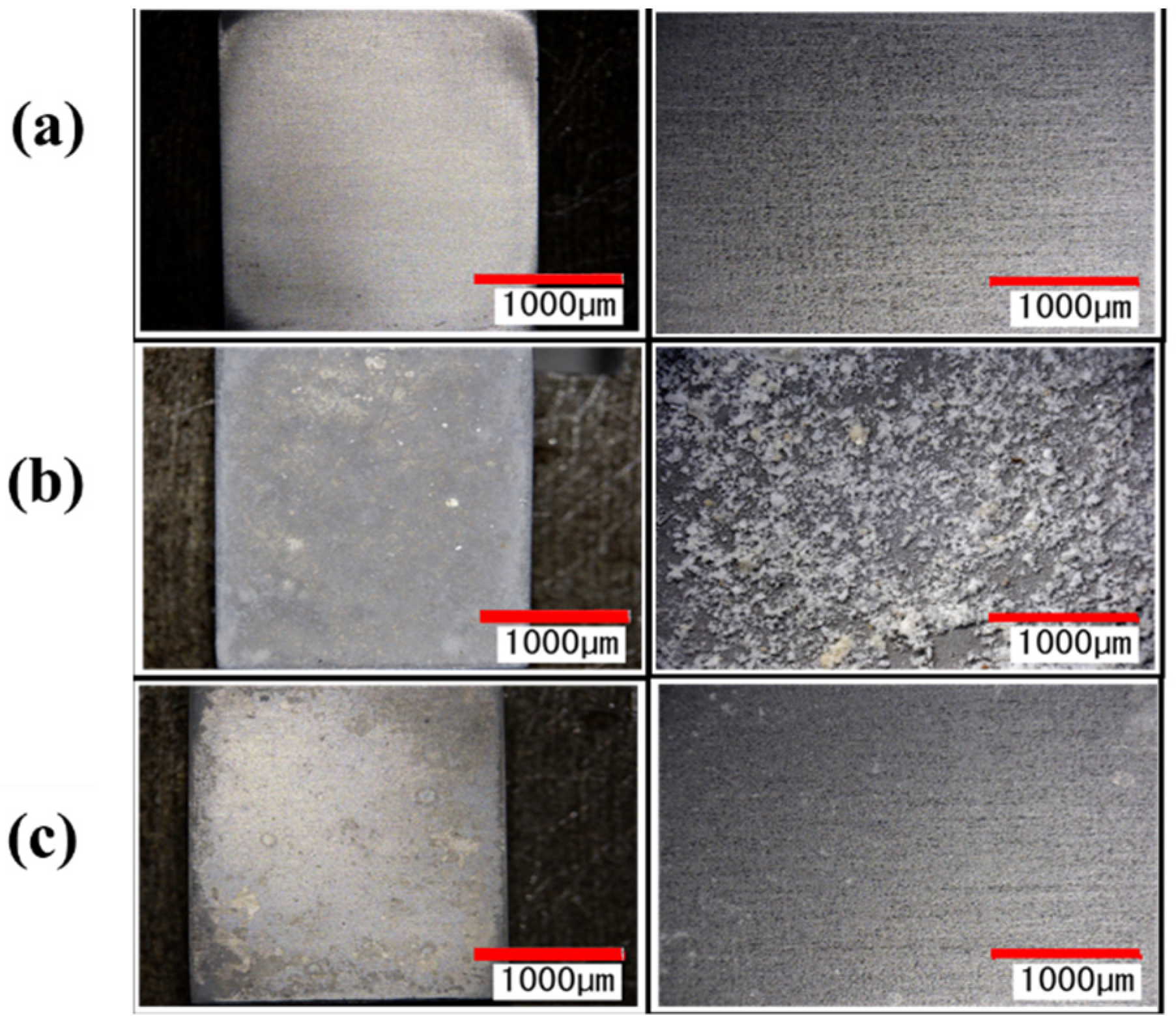
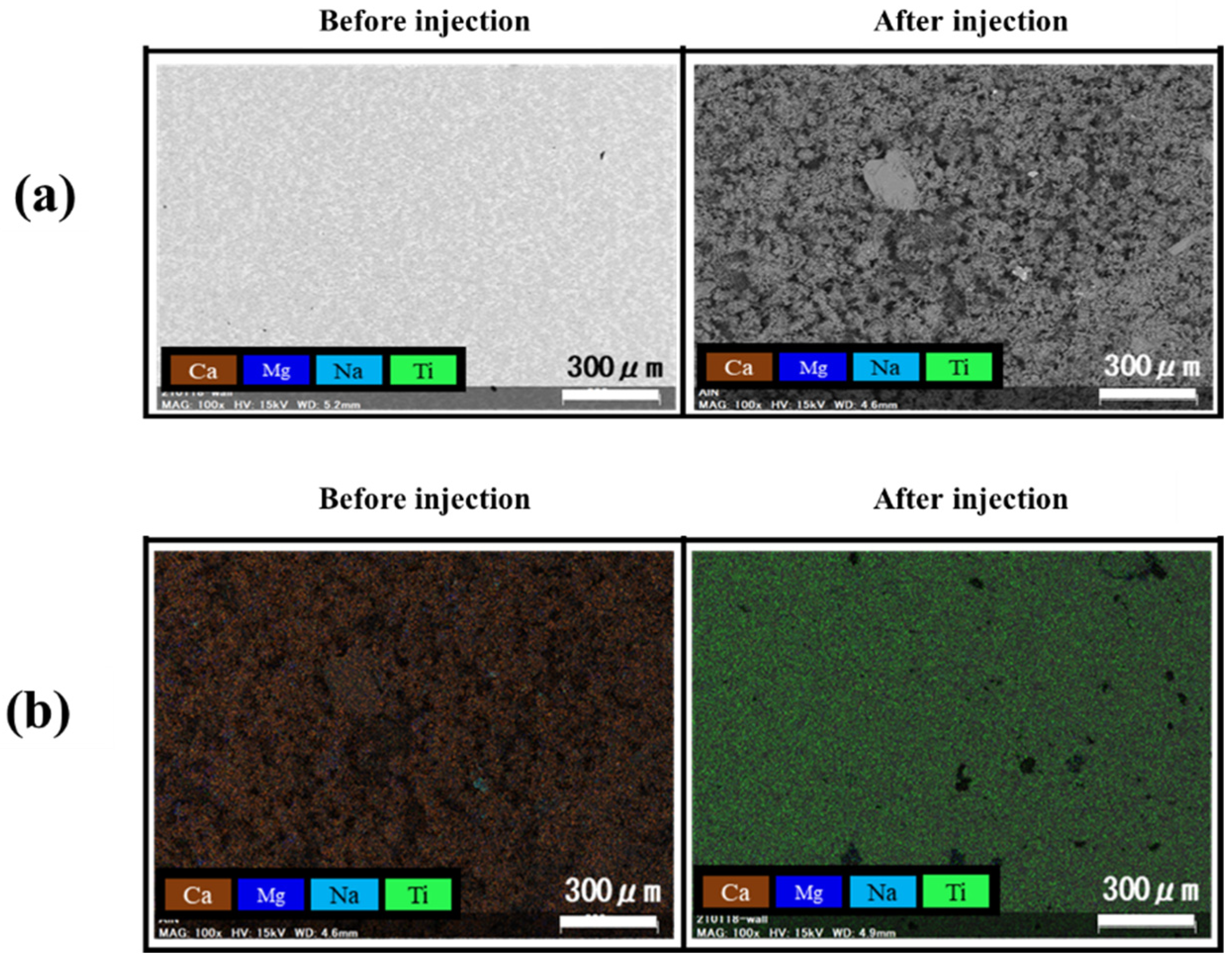
Publisher’s Note: MDPI stays neutral with regard to jurisdictional claims in published maps and institutional affiliations. |
© 2021 by the authors. Licensee MDPI, Basel, Switzerland. This article is an open access article distributed under the terms and conditions of the Creative Commons Attribution (CC BY) license (https://creativecommons.org/licenses/by/4.0/).
Share and Cite
Sato, H.; Ishihata, H.; Kameyama, Y.; Shimpo, R.; Komasa, S. Professional Mechanical Tooth Cleaning Method for Dental Implant Surface by Agar Particle Blasting. Materials 2021, 14, 6805. https://doi.org/10.3390/ma14226805
Sato H, Ishihata H, Kameyama Y, Shimpo R, Komasa S. Professional Mechanical Tooth Cleaning Method for Dental Implant Surface by Agar Particle Blasting. Materials. 2021; 14(22):6805. https://doi.org/10.3390/ma14226805
Chicago/Turabian StyleSato, Hideaki, Hiroshi Ishihata, Yutaka Kameyama, Ryokichi Shimpo, and Satoshi Komasa. 2021. "Professional Mechanical Tooth Cleaning Method for Dental Implant Surface by Agar Particle Blasting" Materials 14, no. 22: 6805. https://doi.org/10.3390/ma14226805
APA StyleSato, H., Ishihata, H., Kameyama, Y., Shimpo, R., & Komasa, S. (2021). Professional Mechanical Tooth Cleaning Method for Dental Implant Surface by Agar Particle Blasting. Materials, 14(22), 6805. https://doi.org/10.3390/ma14226805





